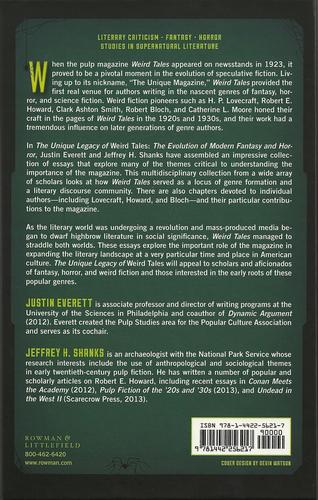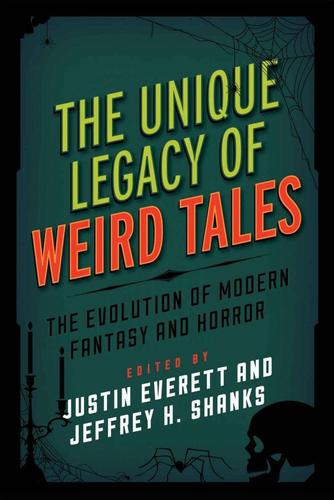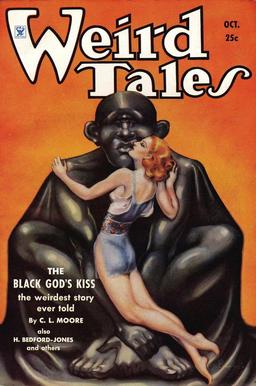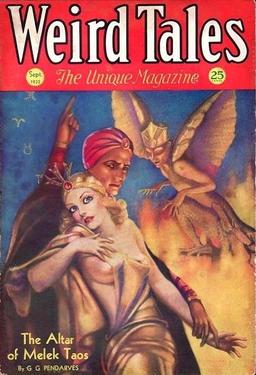New Treasures: The Unique Legacy of Weird Tales edited by Justin Everett and Jeffrey H. Shanks
 |
 |
I was extremely pleased to receive a review copy of Justin Everett and Jeffrey H. Shanks’ The Unique Legacy of Weird Tales, a fascinating collection of essays exploring the history and enormous impact of the most important fantasy magazine of all time.
While it’s primarily an academic volume (the first essay, by Jason Ray Carney, is titled “‘Something That Swayed as If in Unison’: The Artistic Authenticity of Weird Tales in the Interwar Periodical Culture of Modernism”) the book has plenty to offer casual fans. I’ve spent a few days with it now, dipping into various articles, and found it both educational and highly entertaining. This is a great volume for anyone who wants to understand why Weird Tales was so crucially important to the development of American fantasy, and the fan who’s just looking for recommendations on the best fantasy from the early Twentieth Century.
[Click images to embiggen.]

While Weird Tales has been around for over 90 years — and at least nominally is still alive, with its latest issue published last year by Nth Dimension Media — most of the articles I’ve read so far have focused almost exclusively in its early years, when the magazine discovered and nurtured some of the greatest American fantasists, including H.P. Lovecraft, Clark Ashton Smith, and Robert E. Howard. In “‘A Round Cipher’: Word-Building and World-Building in the Weird Works of Clark Ashton Smith,” Geoffrey Reiter writes:
In 1924, one year into its run, Weird Tales published an editorial (now ascribed to Otis Adelbert Kline) that served as a mission statement for the magazine. “Why Weird Tales” placed the pulp publication in the long run of great imaginative literary writers, from Homer to H.G. Wells. with special emphasis on Edgar Allan Poe, celebrating them because, “to the imaginative writer, the upper reaches of the ether, the outer limits of the galactic ring, the great void that gapes beyond, and the infinity of universes that may, for all we know, lie still further on, are as accessible as his own garden.” Perhaps no contributor to Weird Tales exemplified this approach to the imagination better than Clark Ashton Smith, who published more than fifty stories in the magazine, many of them occurring within various story-cycles, such as Hyperborea (a prehistoric northern continent), Averoigne (a mythical province in Medieval France), Poseidonis (an island of Atlantis), and Zothique (a dying far-future realm). Smith rejected the hardline materialism of friends and correspondents like H.P. Lovecraft, contending that for all anyone knew, reality itself might be illusory and that, as a result, an author’s fictional worlds could be just as “real” as the mundane human world.
The book is equally fascinating when it strays beyond the “Big Three.” One of the most interesting articles is Jonathan Helland’s “C.L. Moore, M. Brundage, and Jirel of Joiry: Women and Gender in the October 1934 Weird Tales.” Here’s part of the intro:
Moore was neither the first woman writer in Weird Tales nor the most prolific, but she was arguably the most popular and certainly the most enduring. She and Brundage would go on to be, without question, the two best-known women associated with the magazine, and the October 1934 cover was their only collaboration. However, prior to October 1934, most readers assumed they both were men. That is what makes the October 1934 issue so special: it was in this issue that editor Farnsworth Wright revealed Brundage’s first name, ad therefore her gender, to the world, thereby stirring the pot of an ongoing controversy about her erotically charged artwork.

Of course, there’s plenty here for those who want to dive deep into Lovecraft, Smith and Howard scholarship. Here’s an intriguing sample from Daniel Nyikos “The Lovecraft Circle and the ‘Weird Class’: Against the Complacency of an Orthodox Sun-Dweller.”
Tall and muscular, Kull little resembles a Lovecraftian protagonist, but his ability to sense — and even to be terrified by — the reality of his world demonstrates that he, too, is a fictional representative of the weird class. As a king and barbarian, he is doubly on the margins of society, ruling over a strange and ancient people he has no kinship with. In an interesting turn, Kull’s outsider imagination is able to glimpse what the common people of Valusia have themselves forgotten: the supernatural forces that peer from the recesses of the past and still lurk in the dark corners of the city.
The secret to his survival comes out of the dim past, together with the inhuman menace that threatens to overwhelm Kull… Kull, too, is sensitive to the same cosmic secrets that Lovecraft’s characters are. Rather than buckling to the pressure of what he knows, he rages against it, despite shuddering at the realization of his own insignificant place in the cosmos.
There are a total of 14 articles, divided into three roughly equal sections:
Part I: The Unique Magazine: Weird Tales, Modernism, and Genre Formation
Part II: Eich-Pi-El and Two-Gun Bob: Lovecraft and Howard in Weird Tales
Part III: Masters of the Weird: Other Authors in Weird Tales
The “other authors” considered in Part III include Clark Ashton Smith (two articles), Robert Bloch, and Harold Lawlor.
The authors cover a wide range of topics, simultaneously revealing much of the rich history of Weird Tales, and exposing just how much more there is to study. I’m heartily enjoying The Unique Legacy of Weird Tales, and I hope it’s just the opening volume in a series that continues to delve deep into the history of this legendary magazine.
The Unique Legacy of Weird Tales was published by Rowman & Littlefield Publishers on October 1, 2015. It is 266 pages, priced at $80 in hardcover and $79.99 in digital format.
See all our recent New Treasures here.